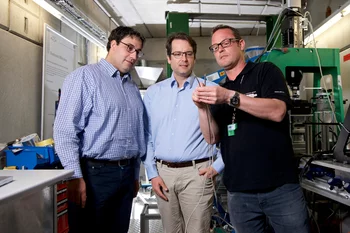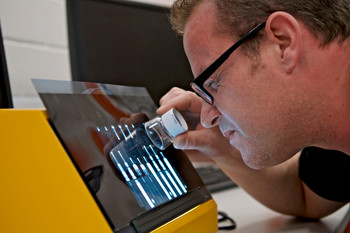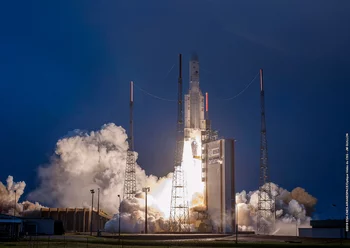Components for ESA rockets are illuminated with neutrons
Rockets from the European Space Agency ESA fly into space with support from the Paul Scherrer Institute PSI. Imaging carried out at PSI in cooperation with Dassault Aviation ensures the quality of certain components of the Ariane 5 and Vega launch vehicles. With the help of the neutrons generated at the neutron source SINQ, PSI researchers are screening so-called pyrotechnic components that are installed in the ESA rockets. These components, which act like fuse cords and igniters, ensure, among other things, that the booster rockets are dropped at the right hundredth of a second. The Ariane launch on 20 June took place with components that had been examined at PSI.
(Photo: Paul Scherrer Institute/Markus Fischer)
(Photo: Paul Scherrer Institute/Markus Fischer)
(Photo: Copyright ESA/CNES/ARIANESPACE-Service Optique CSG; JM Guillon)
The neutron source of the Paul Scherrer Institute PSI helps to investigate certain components before they are installed in Ariane 5 and Vega launch rockets. These space launchers, developed by the European Space Agency ESA, transport satellites and other unmanned spacecrafts into orbit. The elements studied at PSI are so-called pyrotechnic components, which play a decisive role during the rocket flight: They are filled with explosives; some of them act like a fuse cord, while others trigger a series of desired effects. The components that ensured a successful launch of the Ariane 5 rocket on 20 June had been examined at PSI months earlier.
Neutrons serve quality assurance
The pyrotechnic components used for Ariane 5 and Vega rockets consist of a metal casing filled with an explosive compound. "The pyrotechnic signal lines act in a domino effect", explains Christian Grünzweig, physicist in the Research Group for Neutron Imaging and Applied Materials at PSI. Once activated - or in this case ignited - the signal continues to run and triggers specific detonations along the line. "And, as with dominoes, after that, it's over: The pyrotechnic components can only be burnt once. A test run in advance to see whether they will function reliably is impossible."
X-ray images are not suitable for inspecting them, as X-rays hardly penetrate metal. "The good news", says Grünzweig, "is that where X-rays fail, our imaging with neutrons can often help." Neutrons - the uncharged basic building blocks of atoms - penetrate most metals almost unhindered, including lead. "The explosive, on the other hand, contains hydrogen atoms that significantly attenuate the neutron beam and thus make it show up as a dark contrast", Grünzweig continues. "In short: Explosives behind metal can only be made visible with neutrons."
The neutron images are later evaluated by employees of the aerospace company Dassault Aviation. This way it is checked whether the explosives were brought into the components as intended and free of defects. This is crucial because a defect in the distribution of explosives would interrupt the domino effect during burning - the components would then be unusable. The latest rocket launch was the first after the signing of an official cooperation agreement between PSI and Dassault Aviation in April of this year.
Until the satellite is placed
Though at first glance the sequence of pyrotechnic components resembles a fuse cord, their task in space travel is much more complex. While the detonating cords ensure simple transmission of the signal, there are a multitude of other pyrotechnic components. Some multiply the signal so that an incoming detonating cord can be followed by up to nine outgoing cords and thus signals. At other points, detonating cords run through loops in order to bring the signal to a certain location with an appropriate delay. There they trigger tiny detonations whereupon, for example, blades cut through respective holders. In this way the two boosters, performing the first acceleration stage together, are dropped with accurate synchronisation. In the further course of the rocket flight, the protective cladding of the payload is detached in a similar way. Finally, the payload, i.e., the satellite or other spacecraft, is detached from the launcher by further explosions.
"Several crucial processes like these are initiated entirely by the pyrotechnic elements, whose initial ignition already takes place with the rocket take-off", explains David Mannes, also a researcher in the Neutron Imaging and Applied Materials group at PSI.
The versatile uses of neutron imaging
Neutron imaging is carried out at only a few other research institutes worldwide, and in Switzerland it is uniquely possible at PSI. The imaging method has been established here for many years and is accessible to users from industry. The method provides a non-destructive view into the interior of materials and components, which allows a variety of scientific questions to be answered or problems from technology and industry to be tackled. For example, neutron images of a gold bust of the Roman Emperor Marcus Aurelius from the second century AD brought new insights into the processes used to fabricate it. Pictures taken by Grünzweig and Mannes helped the pharmaceutical industry to understand the processes involved in storing pre-filled syringes. And the ABB Wettingen site in the canton of Aargau received recommendations for increasing the production of its industrial ceramic components thanks to PSI neutron images.
Text: Paul Scherrer Institute/Laura Hennemann









